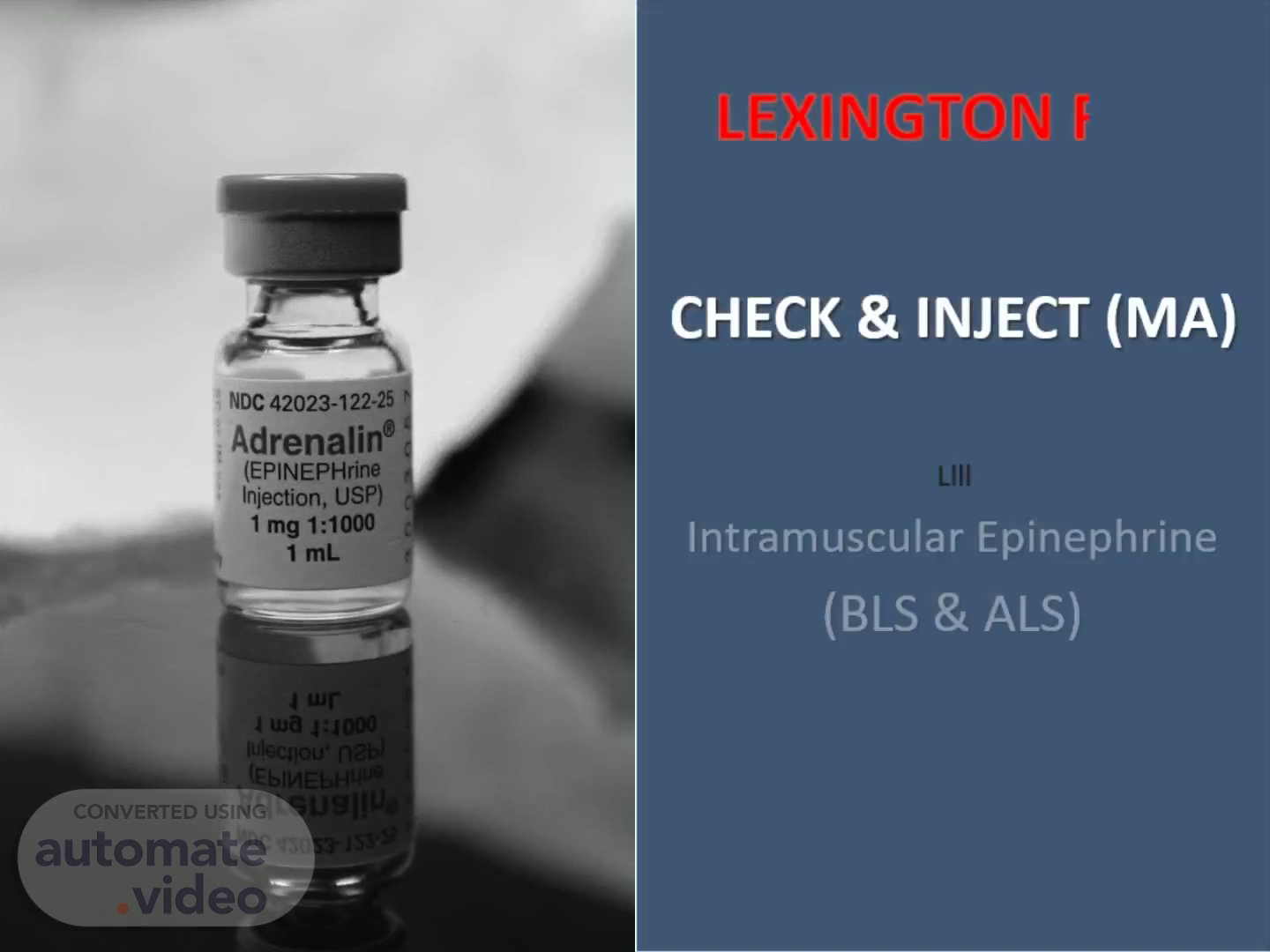Scene 1 (0s)
Llll. CHECK & INJECT (MA). Intramuscular Epinephrine (BLS & ALS).
Scene 2 (16s)
OVERVIEW.
Scene 3 (28s)
3. Increased rate of administration Better recognition of anaphylaxis Safer for providers & patients Decreased costs Improves patient outcomes Epi-Pens still have their utility for prescription and use by patients.
Scene 4 (47s)
4. SAFETY. A recent study has found Epi-Pen auto-injectors used to treat children in anaphylaxis caused lacerations and embedded needles..
Scene 5 (1m 25s)
5. SAFETY. large img. large img. Lacerations and Embedded Needles Caused by Epinephrine Autoinjector Use in Children. Brown, Julie C. et al. Annals of Emergency Medicine , Volume 67 , Issue 3, 307 - 315.e8.
Scene 6 (1m 40s)
6. SAFETY. large img. Lacerations and Embedded Needles Caused by Epinephrine Autoinjector Use in Children. Brown, Julie C. et al. Annals of Emergency Medicine , Volume 67 , Issue 3, 307 - 315.e8.
Scene 7 (1m 47s)
7. SAFETY. Western University in Ontario recently released a similar study reporting 43% bone-hit-rate in toddlers and infants..
Scene 8 (2m 14s)
PROTOCOLS.
Scene 9 (2m 27s)
9. The indications remain the same as the current Massachusetts Statewide Treatment Protocols (version 15.1) 2.2A: Allergic Reaction/Anaphylaxis – Adult 2.2P: Allergic Reaction/Anaphylaxis – Pediatric 2.6A: Bronchospasm/Respiratory Distress – Adult Medic Only 2.6P: Bronchospasm/Respiratory Distress – Pediatric.
Scene 15 (3m 19s)
15. The contraindications remain the same as well: “Use of emergency Epinephrine 1:1000 in patients over the age of 40 or with known cardiac disease and patient who have already taken high dosage of inhalant bronchodilator medications may result in cardiac complications.” Side effects ay include : Palpitations Hypertension Anxiousness Tremors Headache.
Scene 16 (3m 44s)
REVIEW.
Scene 17 (3m 56s)
17. Serious & systemic allergic reaction: Systemic (multi-system) involvement Shock (poor perfusion) Respiratory symptoms Rapid onset Anaphylaxis is life-threatening. It will lead to death if left untreated..
Scene 18 (4m 15s)
18. Common causes: Foods (nuts, shellfish, fruits) Insects (bees, wasps) Medications (antibiotics) Environmental (plants) Products (latex).
Scene 19 (4m 25s)
19. EMS Treatments: Adrenaline (Epinephrine) Immediate treatment Vasoconstrictor / Bronchodilator Improves respiratory distress / treats shock Nebulizers (Albuterol) Antihistamines (Diphenhydramine) Steroids (Prednisone or Methylprednisolone).
Scene 20 (4m 37s)
PEDI. 20. CRITERIA. ADULT. z 6 months old & under 551bs (25kg) Skin/mucosal involvement (acute onset) with either: • Resp. compromise • VS3P After exposure to KNOWN patient allergen & V BP After exposure to LIKELY allergen & 2(+) of the following: • USBP • Skin/Mucosal involvement • Gl symptoms • Resp. Compromise Repeat after 5mins if needed (OLMC required for EMTs) MEDIC ONLY 2 5 years old & under 551bs (25kg) Bronchospasm Repeat after 5mins if needed.
Scene 21 (5m 2s)
KIT.
Scene 22 (5m 14s)
22. Each kit replaces 2 Epi-Pens (adult or pediatric) Training kits are marked training.
Scene 23 (5m 31s)
23. Unused kits are sealed with a green seal. KIT: Unsealing.
Scene 24 (5m 42s)
24. Each kit contains: Checklist 1mg 1:1000 Epinephrine 1mL VanishPoint Safety Syringe (2) 2x2 Gauze (2), Alcohol Prep Pad (2), Bain-Aids (2) Red Seal.
Scene 25 (5m 56s)
25. Checklist must be completed for each patient Use the checklist as you perform the tasks.
Scene 26 (6m 7s)
26. Outside is the checklist & documentation Inside is a reminder of the protocols & 6 Rights.
Scene 27 (6m 44s)
27. Injection site is the lateral aspect of the deltoid Use the alcohol prep pad to sterilize site.
Scene 28 (6m 57s)
28. KIT: Drawing. 81545E2E-EDBE-433C-8E9A-12A7BF273C20.
Scene 29 (7m 13s)
29. Ensure you have drawn the correct dose Expel any extra medication or air.
Scene 30 (7m 27s)
30. Adapted from: Smith, S., Duell , D., & Martin, B. (2000). Clinical nursing skills: Basic to advanced skills. (5th ed.), p394. Upper Saddle River, NJ: Prentice-Hall Health ..
Scene 31 (7m 44s)
31. Secure the injection site; insert in a dart-like motion at a 90 ° angle. Ensure no blood return Push the plunger until contents have been injected; remove afterwards.
Scene 32 (7m 57s)
32. Press the plunger all of the way down to trigger the locking mechanism Dispose of in a sharps container immediately.
Scene 33 (8m 11s)
33. Monitor the patient (response & side-effects) Complete the documentation on the front & back.
Scene 34 (8m 23s)
34. Place the opened Epinephrine vial & checklist in the kit Seal the kit using the red seal & place in EMS room bin..
Scene 35 (8m 37s)
CQI.
Scene 36 (8m 49s)
36. CQI will be performed for each patient with anaphylaxis and/or bronchospasm or respiratory distress, regardless of whether Epinephrine was administered. Director of CQI will review each case. For Age Indication for Administration Provider Information Amount of Medication Used Patient Outcomes Any Complications.
Scene 37 (9m 12s)
“From my experience, and our QA process, on the Check & Inject program, the benefit has far outweighed any risk that we initially thought might be there. This program is safe . ” Jon Nolan , MSO, EMT-P Professional Standards Section Seattle & King County Public Health Emergency Medical Services & King County Medic One.
Scene 38 (9m 35s)
THANK YOU TO PRO-EMS FOR USE OF SLIDES.
